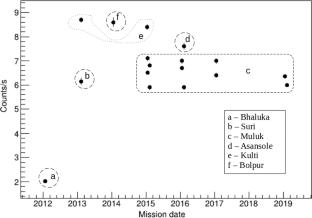利用小型平流层气球任务研究次级宇宙射线
摘要
次级宇宙射线是由初级宇宙射线相互作用产生的,初级宇宙射线是来自外层空间的高能粒子(\(\sim \) GeV),主要是质子(\(\sim \) 89)%) and alpha particles (\(\sim \)10%) with atoms (mainly nitrogen and hydrogen) present in our Earth’s atmosphere. Such rays are dependent on solar activity and geomagnetic latitude through magnetic rigidity and are found to be modulated by these factors. For analysis of secondary cosmic ray data, we use the Indian Centre for Space Physics’s data obtained through small stratospheric balloon-borne experiments. In the present paper, we have measured the secondary cosmic ray intensity at low geomagnetic latitude of \(\sim \)14.50\(^\circ \)N in the low energy range of 25–60 keV from the ground to 30 km altitude for different detectors used in various balloon missions because such missions are almost detecting the X-ray sources above 30 km till 42 km. We also calculated background flux of the detector with the help of some justifiable physical assumptions, secondary cosmic gamma-ray component measurements, and assumed internal background functions. Finally, using our data of 2012–2019, which falls in the 24th solar cycle, we have shown that there is a clear anti-correlation between cosmic ray intensity at Regener–Pfotzer maximum and the solar activity.

Secondary cosmic rays are produced from the interaction of primary cosmic rays, which are high-energy (\(\sim \)GeV) particles originating from outer space, primarily, protons (\(\sim \)89%) and alpha particles (\(\sim \)10%) with atoms (mainly nitrogen and hydrogen) present in our Earth’s atmosphere. Such rays are dependent on solar activity and geomagnetic latitude through magnetic rigidity and are found to be modulated by these factors. For analysis of secondary cosmic ray data, we use the Indian Centre for Space Physics’s data obtained through small stratospheric balloon-borne experiments. In the present paper, we have measured the secondary cosmic ray intensity at low geomagnetic latitude of \(\sim \)14.50\(^\circ \)N in the low energy range of 25–60 keV from the ground to 30 km altitude for different detectors used in various balloon missions because such missions are almost detecting the X-ray sources above 30 km till 42 km. We also calculated background flux of the detector with the help of some justifiable physical assumptions, secondary cosmic gamma-ray component measurements, and assumed internal background functions. Finally, using our data of 2012–2019, which falls in the 24th solar cycle, we have shown that there is a clear anti-correlation between cosmic ray intensity at Regener–Pfotzer maximum and the solar activity.

 求助内容:
求助内容: 应助结果提醒方式:
应助结果提醒方式:


